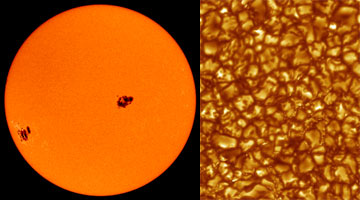The photosphere is the lowest layer of the solar atmosphere and is only about 100 km thick, compared to the size of the Sun - about 1,400,000 km across. It is essentially the visible surface of the Sun. Photons are produced in the Sun's core as a result of nuclear fusion. As they travel outwards they are repeatedly absorbed and re emitted. The photosphere is the last layer of the Sun where this absorption and reemission takes place. Photons emerging from the photosphere pass through a plasma too thin and hot for significant absorption to take place.
Because layers of atmosphere above the photosphere are essentially transparent, we can see many features of the photosphere, including sunspots, which arise because of twisting and breaking of magnetic fields,, and the granular nature of the photosphere, due to convection currents.


